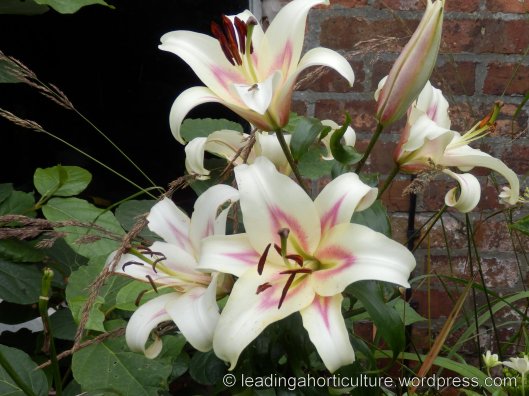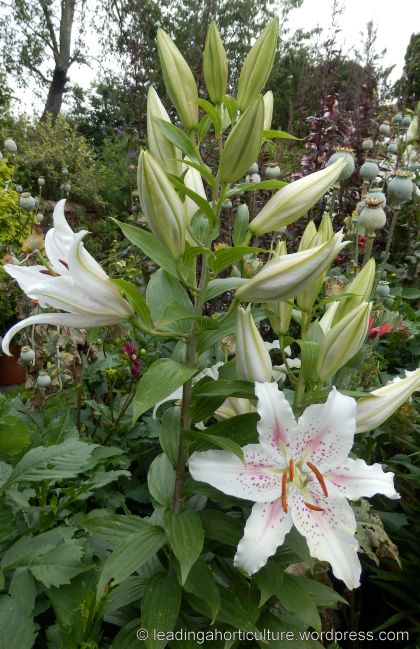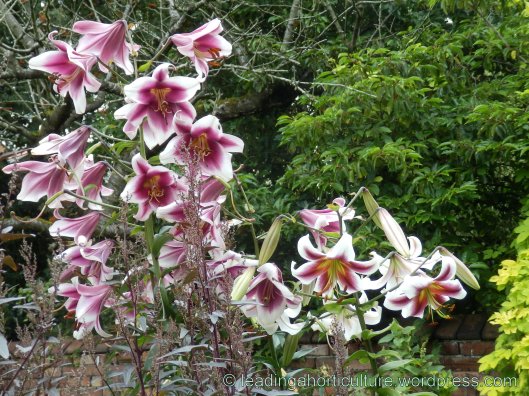Tags
A florist informed me that the stamens should be cut out of blooms in the garden as well as the vase, to make them last longer. I can’t do it. The sacrilege is akin to shaving the hair from Botticelli’s Venus, as bad as knackering the nadgers of Michelangelo’s David. My laundry is drying in the summer sunshine and the warm breeze floats the sheets to flirt with Lilium “Rhialto”, dusting them with rusty pollen. I would rather send the washing back through the machine and drape them around indoors for a week, than emasculate one of my favourite flowers.

Pictures of Lily L. “Bonbini”
The Asiatic species bloom early and tend to be low on fragrance. They have the greatest range of colours and shapes. Like most bulbs, they like lots of sunshine and will not tolerate soggy soil. Given a bit of bone meal, they are perennial, trouble free and fetching. Oriental lilies are taller and later with larger flowers. These are the ones to go for if you have a huge hall to perfume, a vast sitting room to scent. In my garden, tree lilies are bursting from their buds at about six feet (2m.) high. Even these stems are largely self supporting, unless given an outrageous amount of fertiliser or stiff gust of wind. If they start to cant, I support their heavy heads with hopefully subtle struts.

Lili Marlene L. “Muscadet”
The genus name is said to come from the Greek “louloudi”, meaning flower. It is supposed to represent purity and innocence but given the sensual, sinful smell and the silken glory of the petals, I can’t help thinking that they got this one wrong. Lily beetle is a nuisance but not my nemesis. I spray with Provado at night, to minimise bee buggery, twice a year. The insecticide is a systemic, thus deterring the laying of eggs and the subsequent self anointing poop covered grubs which do most of the damage. I still get enough red insects to keep me fit, jumping up and down on their soon to be lifeless corpses.

Lily the Pink L. “Silk Road”
When flowering is finished, I heave a sigh of regret and cut off the dead heads, to save the plant from weakening the bulb by producing seeds. If you are more patient than I, seedlings may be nurtured for future enjoyment, with the possibility of an exciting new strain. The easiest method of propagation is to divide clumps; if offsets are small, it may help to pot them up for special attention, until large enough to tough it out in the border. Bulbils may be taken from leaf axils of stem rooting types, for growing on. The professionals take a single bulb and tear it apart into individual scales. These are cosseted and cherished until they form mature specimens. I tried this by accident, when I fell heavily on a bag full of bulbs, purchased at considerable expense from a stall at a flower show. First I attended to my wounded knees, with much rubbing and some inventive, reprehensible swearing. Then I laid the remains of Lilium orientalis “Tiger Woods” in a warm bed and left him to it. I’m pleased to say that he’s survived but in this instance only, he’s last to appear and thus slow to get his act in gear.

The lilies look wonderful, shame their scent cannot transmit except in the imagination. I shall console myself with your pleasing prose.
Thank you Jam, your pleasing praise is perfect. The lilies are currently towering over my head, scenting the air and the unmentionables on the washing line.
Very pretty! Our lilies are nearly over, except for the Orientals. I keep noting to myself how I should plant more different kinds in more garden areas at this fragrant time of year — thanks for yet another nudge to do so! Best, -Beth
Thank you Beth. It’s a good job that you are gardening in America, or we would be competing for lily bulbs this Autumn. That said, I’m sorry that you aren’t close enough to swap a few plants, without getting Customs in a tizzy. You can’t have too many perfumed blossoms. Best regards, Debbie.
You have some beauties. I haven’t come across ‘Silk Road’ before- gorgeous. Removing the stamens is an awful idea, barbaric. The stamens are part of their charm.
Thank you Chloris. My soil seems to suit them and the lily/Dahlia bed is heavily laden with home made compost, as it has to support so much vegetation. I agree with you on the subject of stamens and will defend them to my last breath.
Tes lys sont splendides et en plus, ils doivent embaumer ton jardin !
Merci Christiane, les lys sont mes bébés parfumés. Ils éclairent les frontières à cette période de l’année, alors que de nombreuses autres plantes dorment.